From internal pipelines, drains are transported by external ...

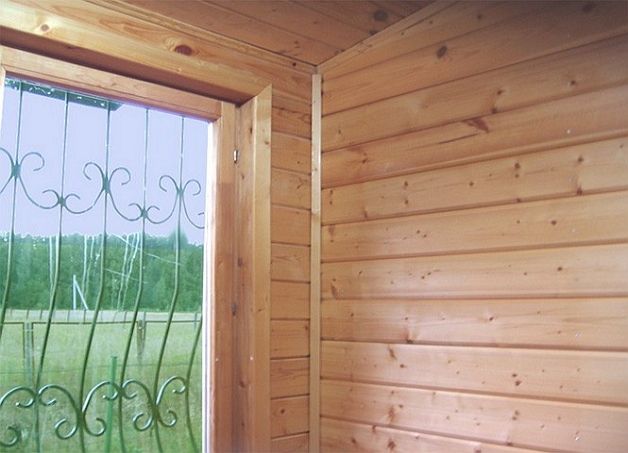
Finishing the veranda can be done with a variety of materials. Along with this, you need to consider that this room is unheated, therefore it is not recommended to use decoration Materialsthat are unstable to moisture and temperature extremes. In addition, it is not recommended to save in the process of acquiring finishing materials.
All finishing work can be done independently, without the help of specialists. First you need to create an approximate project for the work, and then select and purchase materials. The first step is usually to finish the ceiling, then the walls, and in the end - the floor.
Plain wood finish.
The selection of suitable finishing materials is crucial.
Finishing should be done with high quality materials that are resistant to various negative influences.
It is especially important if the veranda does not have full glazing and insulation. Then the finish will be exposed to the strongest influence of atmospheric factors, which cannot but affect its performance.
The choice of one or another type of material for decoration will depend on the personal preferences of the owners and financial capabilities.
Before finishing the ceiling of the veranda inside, it is necessary to properly process all the wooden elements with an antiseptic composition.
After processing, the frame base is installed, for which wooden blocks are used (suitable in size 30x50 or 50x50). They must also be treated with antiseptic formulations. The bars are fastened to the roof rafters using self-tapping screws or long nails. The step of fastening the bars is 30-40 cm. It is important to observe the horizontal installation of wooden elements, for which you need to use the building level.
Also, waterproofing material should be fixed to the rafters, which will protect the heat insulator and finishing materials from moisture. In the case of a veranda, plates can act as thermal insulation materials mineral wool, polyfoam and other traditional heaters. Only then can we begin to fasten the outer skin to the ceiling.
The easiest way is to sew a wooden lining on the veranda ceiling. Installation of wooden lining is carried out strictly perpendicular to the frame bars. You need to nail it on the end with galvanized nails. After the lining of the ceiling with the lining is completed, it is recommended to sand it and cover it with any suitable paintwork composition.
If the ceiling of the veranda is planned to be finished with PVC panels, then the work is carried out in the following sequence:
Similarly, siding panels or MDF can be hemmed onto the ceiling of the veranda. Given the fact that MDF and siding in stores are represented by many models with the most diverse designs, this option has recently been a priority for many suburban homeowners.
If it was planned to hem plasterboard sheets on the ceiling, then it is better to abandon the use of a wooden crate in favor of a specialized metal profile.
Directly on the profile is the installation of elements, to which the plasterboard sheets are fastened. It is better to fix the sheets with self-tapping screws. At the end of the drywall fastening, the ceiling surface needs to be puttied and cleaned, which will prepare it for the final finish.
Finishing the walls of the veranda is quite simple: first of all, you need to mount a wooden frame made of bars. It is important to install as evenly as possible, checking the accuracy of the installation with a building level.

Nice wood paneling.
If you plan to make a warm veranda, then after installing the wooden crate, the walls must be insulated with a suitable heat-insulating material. Before laying the insulation, a waterproofing film is installed, which will protect the insulator and finishing materials from moisture and condensate. All wood materials used must be treated with an antiseptic. After that, the selected facing material is fixed to the wall.
The flooring of the veranda needs special attention. The choice of a particular type of coating will largely depend on the operating conditions. To finish the floor of the veranda, you can use a terrace or massive board, laminated panels, ceramic tiles and other popular floor materials. Water-resistant laminate and terrace board - the best option for decoration. These coatings are quite simple to install, durable, do not require special care conditions.
Water-resistant laminate and decking can be used even in cases where the veranda is fully open from the outside and has no glazing.
In addition, in such cases, as an alternative solution to flooring, preference can be given to traditional ceramic tiles or modern PVC panels. It is also possible to use linoleum. It is worth noting that the new linoleum models have a fairly attractive appearance and excellent performance, so their cost can be quite high.
Outside, the veranda can be finished with wooden lining, although many experts recommend abandoning its use in the outer lining, even if the material has been treated with protective compounds. The most popular solution for the outdoor decoration of terraces and verandas is siding, the models of which can imitate a variety of finishing materials. Siding can be easily fixed to any base.
For facade works, horizontal siding is usually used, equipped with lock joints. Finishing in this case can be done independently. The main thing here is to make a frame (crate), on which plastic siding panels will be installed.
This article is designed to help understand the full variety of materials for decorating a veranda in a private house. Photos of what to sheathe and how to color are also included. The article stipulates the features of the use of finishing materials in open and closed verandas. Materials such as lining, decorative plaster, PVC panels, polycarbonate, etc. will be featured. So, if you are interested in the question of what to sheathe a veranda, then you will receive answers from the article.
Terrace design in a country house in contemporary style (a photo)
Having dealt with the question, it is necessary to proceed directly to its decoration. When choosing, it is worth relying, first of all, on the practicality of the finish and its appearance. It is worth considering and deciding whether the porch will be used for walking, as they say, “on the bare foot”, or whether they will walk on it in shoes.
In any case, the number of different materials for decoration allows you to deploy your imagination to the full and show your creative power. Before buying a finish, a good option would be to create a layout for future design, which will help to avoid:
In addition, the design project allows you to think through more details and choose the best combination for decorating the veranda in a private house. All finishing materials can be divided into different target areas of application:
Most of the materials used for decoration are universal - they are suitable for both open and closed verandas, however, there are various exceptions.
For the interior decoration of the veranda, there are many materials that can achieve a pleasant appearance. Of course, you can use the usual finishing materials, such as wallpaper, however, on the veranda they are likely to not last long and come in indecent form.
This chapter discusses the main types of materials for covering walls on the veranda:
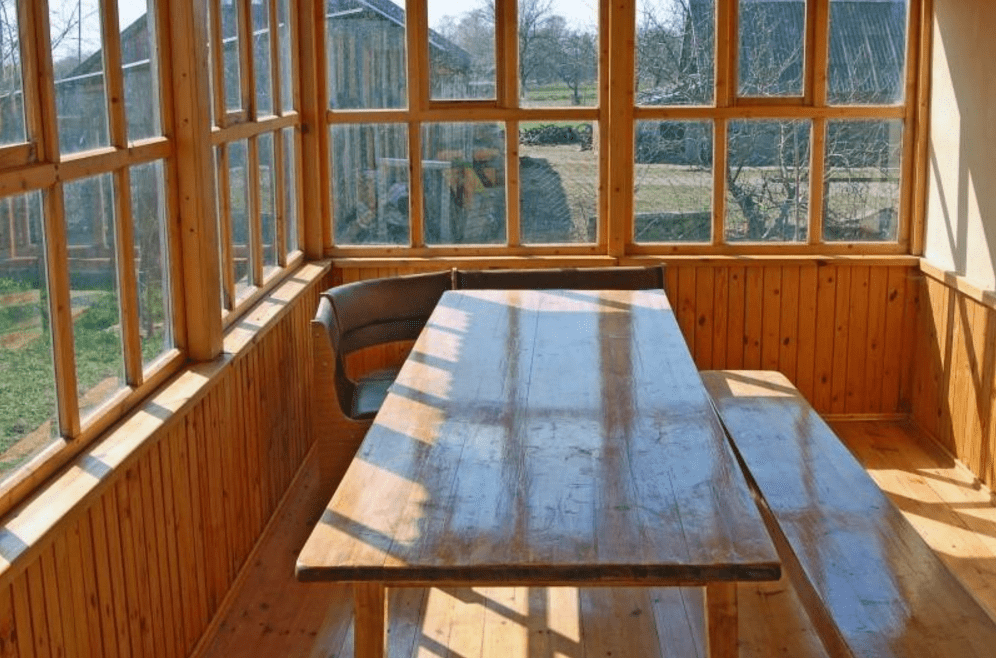 interior decoration
interior decoration All of them require a different level of skill from the master - to sheathe PVC panels is much easier than to finish the wall with plaster, however, and they give effects corresponding to labor costs. How to sheathe a veranda inside? - Let's start with the most popular lining.
 Thermal insulation of the veranda wooden house
Thermal insulation of the veranda wooden house Lining for the veranda classically represents a thin, usually up to 5-10 mm, board made of wood, materials for its processing or plastic. To connect individual boards with each other, a system with spikes and grooves is used, which allows you to quickly and reliably connect the boards to each other.
Previously, the use of lining was considered special chic - the walls lined with lining in the days of the Soviet Union were a huge luxury, since it was quite difficult to get it. Now it is a publicly available material that can be bought at any hardware store.
The lining on the veranda differs in the profile of its grooves and the angle of processing of the faces, allowing you to create different cosmetic effects:
 Separately, American and European lining are distinguished, which has its own peculiarities of use - “American” allows you to imitate the style of laying “overlap”, and “European” has additional crests on the front side, covering the joints.
Separately, American and European lining are distinguished, which has its own peculiarities of use - “American” allows you to imitate the style of laying “overlap”, and “European” has additional crests on the front side, covering the joints. As a material, it is quite whimsical - when choosing a lining from whole wood species, it is necessary to take into account the drying out that will occur after the lining is fixed to the wall. MDF wall paneling does not require such an attitude, however, with very high humidity in the room, over time it can absorb moisture and take on an unsuitable appearance for wall covering.

To finish the veranda with a lining, you only need a screwdriver and kleimers - special metal latches that are screwed to the board and allow you to speed up the process. The spikes of the boards are longer than the grooves, which is a protection against the destruction of an even row when the board dries, so do not try to push the spike all the way.
This type of interior decoration of the veranda in a private house (photo is enlarged) is a special mixture that, when dried, creates a finished, in case of using colored and textured plasters, or an unfinished wall covering. 
At the moment, there are a huge number of decorative plasters for the veranda:
The appearance of the coating with plaster determines not only the material, but also the application technique. Using various smear methods and experimenting with the amount of mass on a spatula, various visual effects can be achieved. With its help, craftsmen can make whole pictures - sgraffito, which are distinguished by great strength and durability. 
Of all types of plaster, only silk is not suitable for use on open porches - the material is very sensitive to changes in temperature and moisture, which will lead to its damage after the first frost and high dampness after rains.
Polyvinyl chloride is an extremely versatile and convenient material, which is essentially plastic. Panels from it can take any shape, and colors are limited only by the imagination of the designer and the possibilities of colors. 
Panels from it have:
Another huge plus is the cost - one sq.m. PVC panels will cost you a lot less than a meter lining or MDF panels. 
On sale there are both ordinary panels without special processing, and lining, with a system of pins and grooves. The process of finishing the PVC veranda is very simple - it happens with the help of fasteners. The panels can be screwed with ordinary screws at low power, however, this is not too beautiful and you risk easily chopping the sheet with too much effort. 
Lining made of PVC is mounted similarly to a conventional lining, using kleimers and screws. She has the most diverse profiles - it all depends on the manufacturer.
The main disadvantage of PVC products is their low frost resistance - at temperatures below -15 degrees, the panel may crack.
The word MDF comes from the abbreviation of the English name - Medium Density Fibreboard, which is translated into Russian as medium density fiberboard. The material is shavings of different wood species compressed by high pressure under temperature. It is an environmentally friendly material. 
Panels made of MDF for covering verandas are made up to 10 mm thick and have:
The main disadvantage of MDF is the low resistance to moisture, which is seriously reduced in the presence of open ends or chips without coating. The plate swells and, over time, breaks up into shavings. 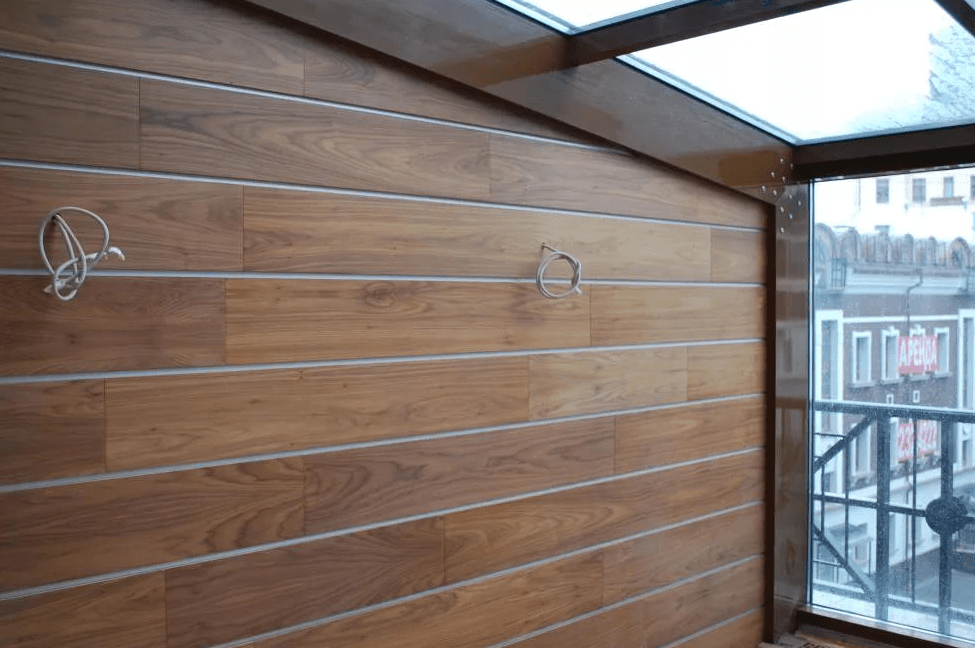
MDF panels are made both as separate sheets, and in the form of lining and other products for decoration. It is easy to work with them - you can simply screw them with screws. The material is diverse - the coating has many different textures and colors.
Having discussed the issue of how to finish the walls of the veranda inside, we go directly to the ceilings.
Ceiling coatings have a separate feature - if possible, the material should be light and resistant to moisture, which can get on it from the roof. 
To finish the ceiling on the veranda, we will consider the following options:
All these materials are easy to install and do not require special temperature conditionsmaking them truly universal.
When making the ceiling on the veranda, you need to take into account the future location of the light sources - they can add an extra twist to the room with the right ceiling coverage. 
A prerequisite is the use of skirting boards - not a single material will give you an ideal ceiling without noticeable joints, and when creating wooden coatings, it is necessary to leave additional spaces for the expansion of wood after drying.
Lining on the ceiling is no different from lining on the walls. Using it immediately on two surfaces of the veranda - the ceiling and walls - allows you to create a complete, noble design of the room. A direction can create a special effect - it can be launched diagonally by adding a game of geometry to the room, or by continuing to wall paneling. 
A feature of the lining of the veranda inside the lining is only the use of a lighter ceiling lining, up to 7 mm thick, and a slightly more complicated installation with tracking of the indentations from the walls, which are laid for the possible expansion of wood due to an increase in temperature. Finishing the ceiling and walls with lining, it is necessary to take into account the width of the boards. For a pleasant appearance, it is advisable to continue the joints of the walls on the ceiling, making the same arrangement of boards. ![]()
As a ceiling material, polyvinyl chloride is universal - it can be used both on the veranda and in the house. The panels are very convenient for ceiling work - they have a very low weight. 
The process of decorating the veranda in a private house (photo clickable) is simple and combines decoration and alignment - using guides from metal profiles, it is possible to create a perfectly even ceiling without unnecessary time costs. Profiles are mounted at the desired length - usually 50-80mm is enough to remove even a noticeable difference, after which the necessary wiring for the fixtures is thrown under them and the entire structure is sheathed with panels.
The material is quite thin and soft, therefore, if necessary, it can easily be cut with an ordinary construction knife into the necessary parts. Each panel is protected by a film, which must be removed after installation. ![]()
A variety of material allows you not to limit the creative space, but for the ceiling it is better to look at the glossy options that visually increase the room.
Polycarbonate is a very pleasant looking material. At the moment, it is produced mainly in two forms:
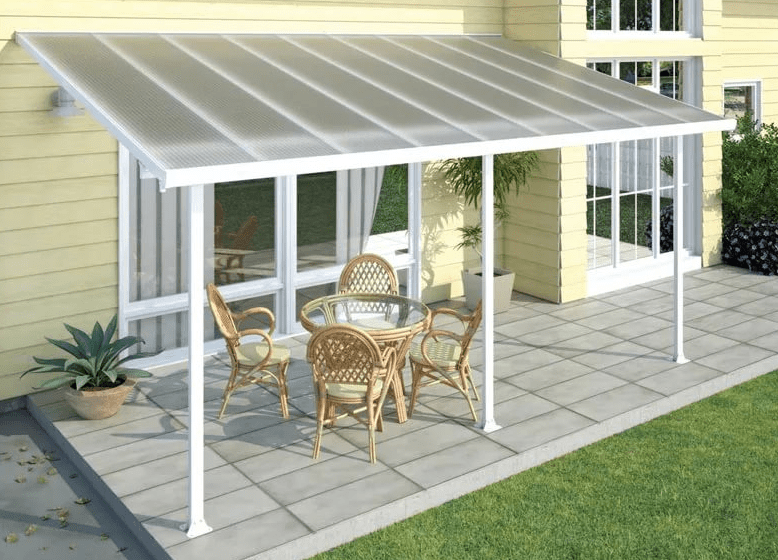 The advantage of this material for the ceiling is its transparency, which imitates glass, in the absence of the disadvantages of the latter: fragility and heavy weight. It is possible to give it any color scheme. A good option is to decorate the polycarbonate ceiling together with a transparent roof, which can create a unique-looking veranda, completely filled with sunlight.
The advantage of this material for the ceiling is its transparency, which imitates glass, in the absence of the disadvantages of the latter: fragility and heavy weight. It is possible to give it any color scheme. A good option is to decorate the polycarbonate ceiling together with a transparent roof, which can create a unique-looking veranda, completely filled with sunlight.
The polycarbonate is mounted on the veranda by pressing it along the edges, in the case of small individual plates, or with the creation of a frame and subsequent sheathing. 
Particular care must be taken when working with wires - they must be fixed on opaque areas, otherwise they will spoil the whole effect of the transparent ceiling.
Such a design solution will give a special "rustic", in the good sense of the word, a shade of the veranda. The only difficulty is the installation of fixtures - weaving does not always come out strong and making a straight hole in it is quite difficult. 
Wicker bamboo ceiling for the veranda is made of thin plywood, 3-4mm, or veneer. It is enough just to dissolve a large sheet into segments of 50-150 mm and bind them together. The ends are lined with perpendicular ribbons.
For fastening, it is necessary to add several transverse slats to the ceiling, at a distance of about 1000-1500 mm, to which sections of the tape are nailed with slate nails with wide hats and thin legs. It is better to raise the weave with the help of ropes that are fixed on the transverse logs. They start from a narrower edge - a good braid will not fall apart from such an impact. 
Difficulty may arise at the fastening stage - plywood and, especially, veneer easily crack due to strong impacts, therefore it is better not to rush and slowly hammer nails.
Having examined the main points of the interior decoration of the veranda in a private house (clickable photo), we will move on to the final and no less important stage - covering the floor.
Sex is very important - tactile sensations are taken from him when walking. You can consider the following types of flooring for the veranda:
 Choosing flooring, you need to build on what kind of building it will be - open or closed, whether it will go in shoes or barefoot. With a “clean” veranda, one must not forget about the possibility of placing carpets or other decorative coatings.
Choosing flooring, you need to build on what kind of building it will be - open or closed, whether it will go in shoes or barefoot. With a “clean” veranda, one must not forget about the possibility of placing carpets or other decorative coatings.
We proceed directly to discussing the issue of what to make floors on the veranda, we start with tiles.
Perhaps this is not the easiest option, but the most practical. The tile itself:
You can lay out various geometric patterns with tiles, combining the shape of the tile itself and the pattern on it. ![]()
To place the tiles on the veranda, preliminary preparation of the floor covering is required - alignment and screed. Otherwise, the tile will “play”, creating bumps and discomfort for the legs.
To work with tiles, tile glue is required, which is applied to the back surface. Between themselves, the individual parts must be aligned in level, and between the corners special crosses are laid, leveling the seams in size. The joints are masked with a special grout that remains in the seams and is easily erased from the surface. 
The main difficulty can be cutting to custom sizes - smooth edges are quite difficult to do without a special tile cutter, which costs quite a lot of money, however, if necessary, you can ask to cut the tiles of your comrades with this tool, or cut the tiles with a hacksaw or grinder.
The terrace decking board, also called decking, is specially processed lumber. It has three layers - the bottom, representing the surface with grooves for ventilation, the middle, having cavities for the expansion of wood and the upper, smooth, front layer. 
Benefits of a veranda floorboard:
Appearance depends on the coating and the material used, of which there are a huge number of combinations. If use is planned in open areas, it is better to give preference to varnished or impregnated from damp. 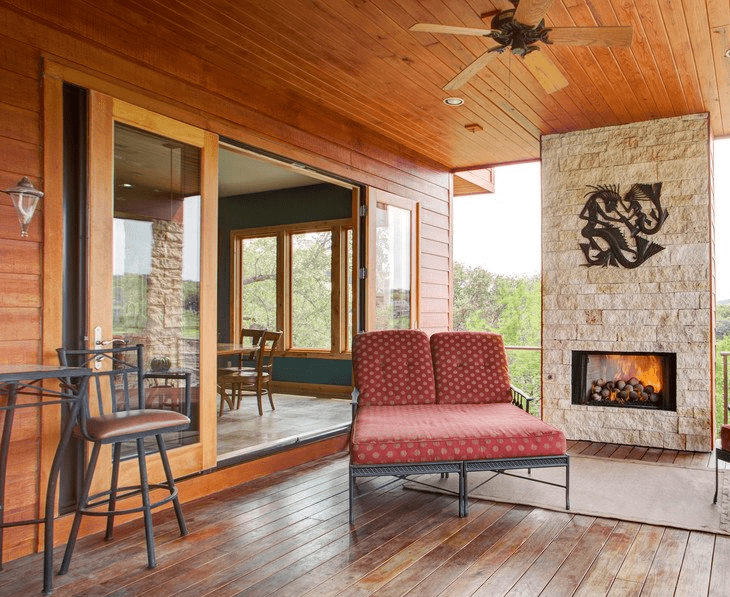
For the floor on the open veranda, the creation of a frame and transmission of lags is required. Logs are placed perpendicular to the direction every 400-600mm. After that, the board is simply nailed or screwed with screws. It is necessary to work with this material very carefully - a blow past the nail can spoil the appearance of the coating. 
Studying the question of how to cover the floor on the veranda of a private house, we pay attention to linoleum. It is made from a combination of polyvinyl chloride and polymers, which gives excellent qualities for flooring. Linoleum:
 Linoleum there is a huge number of species and picking it up for the design is quite simple. There are those that mimic parquet or stone, and quite naturally, and they can only be distinguished by a detailed examination.
Linoleum there is a huge number of species and picking it up for the design is quite simple. There are those that mimic parquet or stone, and quite naturally, and they can only be distinguished by a detailed examination.
 Finishing the veranda in a private house - linoleum photo on the floor
Finishing the veranda in a private house - linoleum photo on the floor For installation, it is enough to have a relatively flat floor surface for the veranda on the street or indoors. The roll is simply rolled out, leveled and attached along the edges of the plinth. If necessary, it can be cut into separate sections and fastened with a special bar. This is useful if there are narrow passages where it is impossible to insert a single piece.
For an insulated floor, it is possible to use a polyvinyl chloride lining, which is quite cheap and allows you to eliminate some of the surface imperfections under the linoleum, creating a heat-preserving lining.
The rubber covering for the veranda is essentially rubber. The flooring from it represents individual tiles or monolithic pieces that have unique properties:
 The floor on the porch of the rubber cottage gives you the opportunity to create the most diverse design with great strength and durability. To work with it, you need a prepared flat surface. When installing the cover with individual modular tiles, no special tools are needed - with a small floor area, they simply mesh together and are strengthened by a skirting board at the edges.
The floor on the porch of the rubber cottage gives you the opportunity to create the most diverse design with great strength and durability. To work with it, you need a prepared flat surface. When installing the cover with individual modular tiles, no special tools are needed - with a small floor area, they simply mesh together and are strengthened by a skirting board at the edges. 
For ordinary tiles, polymer glue is needed, which attaches it to the place. Installation is similar to normal, ceramic tileshowever, joints can be made close, without leveling them with crosses.
The roll resembles a regular linoleum with a smaller roll width. The joints between it are welded with a special soldering iron or a building hairdryer with a thin nozzle, or sealed with polymer glue. 
Concrete floor for the veranda is the simplest and at the same time heavy version of the coating. For him, you only need to have a pre-made monolithic foundation, or cover the floors with concrete slabs. 
Such a coating:
Of course, it is not enough just to lay the concrete slab on the ceiling - you need to polish it. To do this, stock up on a polishing machine, abrasive diamond ribbons or circles and lots of patience. 
The polishing process begins with the use of the largest grain tape (they are marked by the number of grains per square centimeter - 40, 80, 160, 320, and so on) and walk them all over the surface. After that, a tape of less abrasiveness is taken and everything is done anew, until the surface reaches a uniform shine.
Having dealt with the question of how and how to lay the floor on the veranda, we will move on to painting it.
Painting the veranda is an excellent option for protecting flooring. The paint protects the floor from damage and corrosion. Various materials lend themselves to painting:
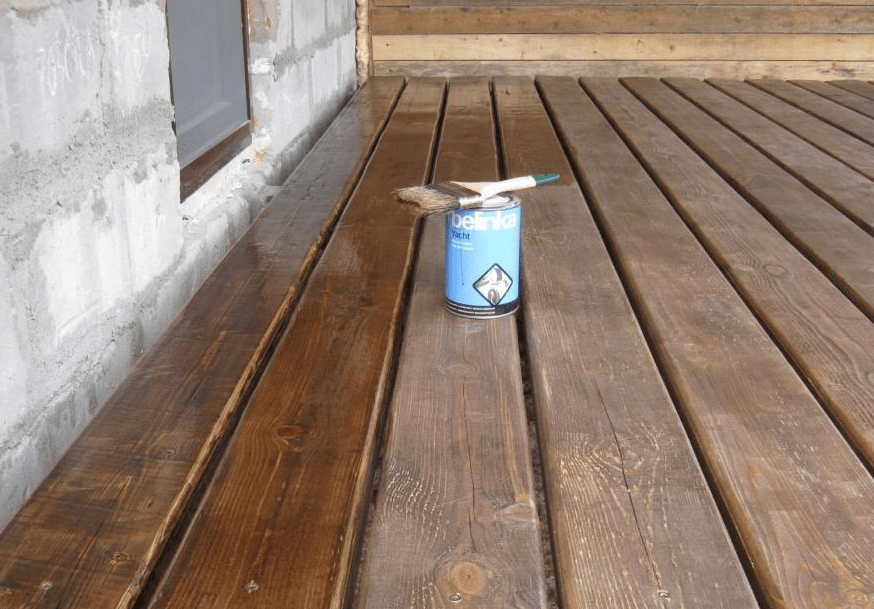 How to paint the floor on the veranda in the country, except as not acrylic paint
How to paint the floor on the veranda in the country, except as not acrylic paint Acrylic, alkyd, nitro enamel and oil paints are the most optimal for painting the wooden floor of the open porch. For good wood, you can also use stain or varnish. Before painting the veranda board, the floor must be cleaned from the remnants of the previous paint, if any, and sanded.
When painting, it is necessary to dip a brush or roller from excess - otherwise, accumulations of paint will form in the recesses, which will ruin the appearance. After painting, it is better to polish the varnish, otherwise it will be too slippery for walking.
Concrete floors are best painted with epoxy, acrylic paint or polyurethane enamel. Epoxy paint is not completely painted - it is rather “rolled out” on the floor with a special spatula to an even layer. It does not wear off over time and gives a very bright color. 
How to paint the floor on the veranda in the country? Choose acrylic paint and polyurethane enamel. They are applied with a regular brush or roller. Before painting, the surface is best cleaned from dust and primed, which will provide a better adhesion of the paint.
To make it easier for you to make a choice, we have compiled for you a small table of the most convenient and popular materials for decoration.
| A place | Material | Appointment | Justification |
|---|---|---|---|
| 1 | Lining | Ceiling and walls | Environmentally friendly material, does not require special skills from the master. Allows you to create design solutions that will always look natural. You can update - sand and re-coat with varnish or stain. |
| 2 | Pvc panels | Ceiling and walls | Cheap and affordable material, easy to use. It has a low mass. On sale you can find a large number of textures and colors. However, it rarely looks natural and is not too durable. |
| 3 | Linoleum | Floor | Easy to operate and practical at low cost. Large assortment with various colors and textures. It imitates parquet and natural stone very well. The downside is the limited area of \u200b\u200buse - it looks good only on the floor. |
| 4 | Network | Ceiling | It looks very impressive. A variety of plywood allows you to create various design solutions. Requires accurate installation, difficult to work. It is placed only on the ceiling because of its fragility. |
| 5 | Terrace board | Floor | Decking is convenient in work, allows you to create a natural plank floor. The material is extremely durable due to ventilation and immediately prepared for placement. However, it costs decent money and is not too convenient for working in the house. |
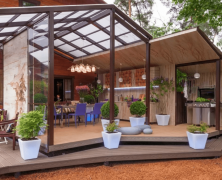


No one a private house or a summer house can’t do without a veranda - a place where home comfort and pacification of wildlife occur. What decoration to choose, how to arrange furniture and fit the design into the surrounding space?
Veranda - this is probably the best place in the country or in a country house, where you can fully relax and feel the unity with nature. It can be solid, insulated, functionally planned and thoroughly furnished. Or to be light, furnished with country simplicity - such that with the onset of cold weather it could be freed from furniture. However, any veranda needs a certain interior decoration, which will create that unique atmosphere of proximity to nature.
The most important thing is that the veranda is in harmony with the architecture of the house, its interior decoration has something in common with the interior. It is also important that it is correctly entered into the surrounding landscape.
It all depends on the style in which the decoration of the house itself is sustained. But at the same time, the atmosphere of the veranda should convey its purpose - a place for relaxation and meals. Therefore, rustic styles, for example, country, Provence, Russian style, in which comfort is intertwined with simplicity and charm of rural life, are perfect. If you want something special, you can choose Japanese or eco-style. Or build a patio in the spirit of the Roman Empire with fountains, flowerpots and terracotta tiles on the floor.

Only natural materials will be appropriate in the interior. Walls can be finished with stone or brick, making a reference to the loft style. The tree will also look organic. For flooring, it is better to use a wear-resistant, unpretentious material - for example, granite. Panoramic glazing is traditional for most verandas: sunlight passes through it and the greenery of the garden is visible. If you equip the veranda with sliding glass doors, you can let the garden and its freshness in at any time, or isolate yourself from dampness when it rains.

The palette for finishing the veranda is also better to choose a natural one. In this border zone between the house and the garden, natural green, gray-brown, terracotta shades with bright accents will look very beautiful.
It is important to plan the space inside the veranda in accordance with your expectations and the functions that the veranda will fulfill in the house. If you rarely use it for cooking, and more like a place where you can sit and have a cup of tea in the shade, you will need an uncomplicated dining group (table and light chairs) and a small brazier to sometimes cook a barbecue for households.
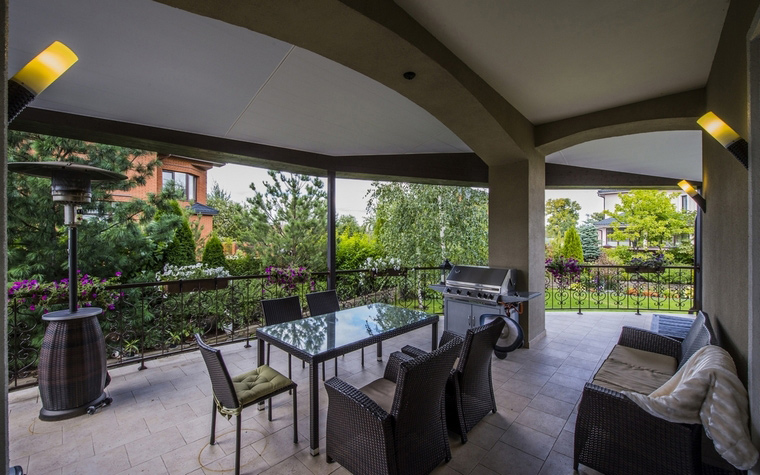
If you are a connoisseur of country feasts with many friends, then it is better to make a competent layout on the veranda. Select the dining area and the cooking zone, organize the whole kitchen: build a stove, including an oven, hob, skewer, grill and tandoor, as well as put a cutting table, hang cupboards for dishes. Then inside the house you do not need a hotel kitchen.
The open veranda should be equipped with special garden furniture. It is made of resistant materials that are not afraid of moisture, cold, and do not deteriorate in direct sunlight. Necessarily need a table and several chairs for households. Crockery and food can be safely stored at home, so cabinets are most likely not needed. But flower pots or flowerpots, a rocking chair or a hanging chair, sofa swings will be on the open veranda very handy.

You will need much more furniture if you are working on the decoration of a glazed veranda that plays the role of a kitchen-dining room at home. Here, for the interior, you can already choose a solid expensive furniture: soft sofas and armchairs, a round table to fit more guests. Undoubted decoration will be the wooden shelves of wood - the very place for beautiful plates. Do not forget the old grandmother's buffet.

Finishing the veranda ends with a choice of decor and accessories. Since this area combines the functions of a relaxation corner and a kitchen-dining room, the decor should be appropriate, cozy. The mood of warmth will be created by family photos on the walls, paintings with landscapes and still lifes, painted dishes and intricate candlesticks.

More examples of interior arrangements of verandas can be found in the photo with design projects from professionals.
A private house or private estate forms a single whole with the territory adjacent to the house. The veranda should look organically in the surrounding landscape, and the garden approaching it should be a continuation of the chosen style. In short, if the preference is given to the English style, then the garden should be English. And the eastern porch will fit into the Japanese rock garden. By the way, the veranda can be combined with another functional area:
Most often, speaking of the veranda, we mean an open or closed annex to one of the walls of the house, where it is convenient to spend time relaxing or having lunch. But the terrace, being one of the varieties of the extension to the house, differs from it, although their concepts are somewhat similar. A terrace is a structure with supports on poles, a roof adjacent to the house of one of the parties. From this side there is an exit to the terrace from the house. The other sides are open, the effect of unity with nature, which gives the terrace, is very strong. Even heavy rain, which can be observed under the roof of the terrace, fully feel its dampness, humidity, hear all the sounds, will not soak the one who is on the site open on three sides. And a cup of tea before bedtime, in a chair in the fresh air - a luxury that is not available to many.
As for the veranda, this building is both on the first floor and on the second. Cottages with such a structure on the second floor look pretty stylish and spectacular. Therefore, much attention is paid to the decoration of the covered porch on the second floor - this indicates the status of the owner, his taste. This room also has a roof, which can be made in the traditional way, and can be glass, which will allow a large amount of daylight during the day to be in the room.
Finishing an open porch in the country (from the photo you can see that it can be stylized for anything) requires a special creative spirit. You can decorate it with evergreen cypress seedlings around the perimeter, then it will turn into a building in the Greek style. You can make the decoration of the veranda inside in the form of a winter garden or a stone palace.

Carefully thought-out interior will give this building a special look, make your own corner of creativity and imagination from an ordinary house. Decorating the pillars of the veranda with wood carvings or decorating them with curly ivy or vines will give a charming look to the design of the terrace.
This design is being built both on one side of the house (open or closed type), and around the house. If it is built in length along the perimeter of the house, the structure looks like a gallery; if it is an extension of a rectangular type, it looks like a pavilion. For the summer period, the construction is built without insulation and glazing. Wall decoration on the veranda can be done in different materials. And for the winter, the living room goes into one where the windows are equipped with double glazing. Finishing a closed veranda in a private house (see photo) even allows the installation of a fireplace (bio fireplace or fake fireplace) to create a cozy atmosphere in which it will be comfortable.

There are verandas different types, depending on how the design of the house is conceived, choose the outdoor (terrace) or indoor (glazed) types. Different lining options will create a different impression when creating the design.
It is also important what the decoration of the veranda will be, because the main purpose of this extension is in the comfort of those who spend their leisure time here. Guided by your own taste in the finishing process, do not forget about some rules in order to get the desired result.
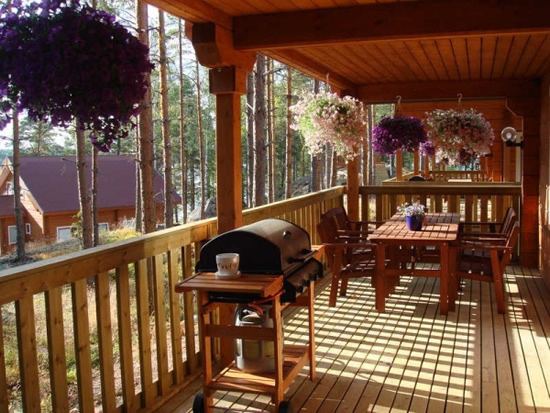
If the decoration of the veranda in a private house (pictured) suggests that it will be open, you need to make sure that the building materials that you will use for decoration are resistant to atmospheric precipitation and dampness, withstand high humidity.

Among these materials, plastic panels, perforated sheet, tile, stone have worked well. A tree in the decoration of the veranda inside with its own hands provides for mandatory preliminary impregnation with an antiseptic, this step will avoid not only premature deformation of wooden elements, but also protect the walls, floor, pillars from rodents.
If the private house where the terrace is planned to be built is located on the seashore or on the shore of the reservoir, it will be interesting to make the porch trim with polycarbonate - transparent walls will protect you from dampness on cool evenings, but will not impede the wonderful views from there.
Typically, summer rooms do not need glazing, it is used only in the warm season, this seasonality does not provide for monolithic buildings or stationary cabinet furniture. Light plastic models of chairs, tables, or transforming furniture are more suitable here. Wicker chairs, tables, rocking chairs, fresh flowers suspended in a cache-pot around the perimeter of the terrace perfectly create a themed interior.
One of today's fashionable solutions in construction is the choice of a frame veranda. For the construction of such a structure, laying the foundation, erecting the frame of the building will be required. Options for finishing the veranda are a matter of taste and opportunity, but the principle of creating the design is almost identical.
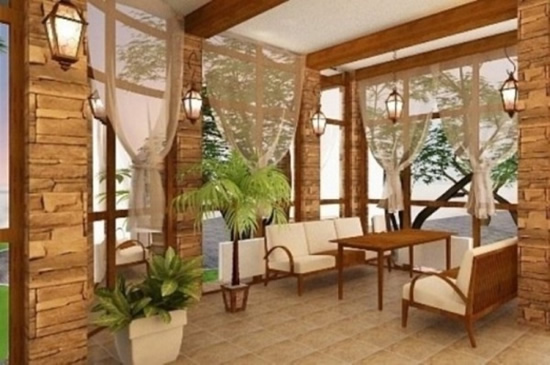
Will be required concrete poles concrete (to build the foundation), a wooden beam for building the frame, a perimeter lath for its lower part and finishing materials for the interior decoration of the walls of the veranda (pictured is stone finish):
If you purchase brackets, angles, screws, anchors, tools, you can make a veranda with your own hands.
As a roof, wood, metal, profile sheet, metal tile, glass, etc. are used at will. When finishing the covered veranda inside (on the photo there is a wooden roof), you need to take into account the degree of natural light, because the only communication that is needed here is electricity.
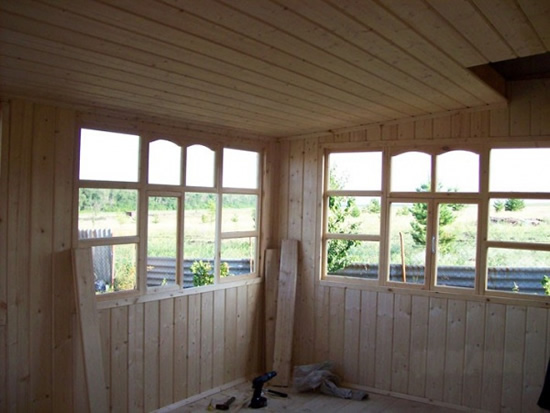
The floor will need waterproofing, and, depending on the chosen style, type of surface, floor slabs or stone are used, you can put beautiful high-quality linoleum. Do not rely on the fact that the plank floor or laminate will be used, remaining as spectacular, beautiful - if the option is open, summer, the interior decoration of the veranda in a private house (see photo) for the floor is also subject to dampness, humidity. Therefore, it is better to give preference to those materials that do not absorb moisture.

A perforated sheet for finishing the veranda inside will help to divide the room into zones (for example, a dining area and a relaxation area), showing imagination, you can perfectly decorate the ceiling with it.
It is important in the interior decoration of the veranda to correctly calculate the lighting.
One of the most popular ways to make a closed terrace not only beautiful but also warm is to finish the veranda plastic panels (in the photo you can see this option).

In itself, it is a lightweight structure, so the interior decoration of the veranda in the country (the photo illustrates one of the options), the ability to make windows without using a two-layer double-glazed window. It will be much more effective to take care of the insulation of the floor and walls. As a finish inside the veranda at the cottage, moisture-resistant gypsum boards are suitable; first, hydrophobization of the walls of the structure should be carried out on both sides: inside and out. To insulate the walls, you can use mineral wool or extruded polystyrene foam. The interior decoration of the veranda (photo) is a gasket of insulation, which is carefully layered with a vapor barrier film, and sheets of MDF, drywall are applied on top, strengthen pvc panels or clapboard.

Advice! When choosing mineral wool as a insulation, remember about its moisture absorption, so that in the near future the insulation does not crumble into dust, provide waterproofing to the walls!
Wall panels for interior decoration for the veranda can be made of any material, even painted with decorative plaster. Wood panels will look very impressive and respectable, but you need to remember that they need care. Cheaper and more practical finish porch imitation of a beam (photo), even on an open structure, this type is preferable due to its durability.

Lining - one of the simplest materials, characterized by wear resistance, good qualities for damp rooms, undemanding to care.
The advantages of finishing the veranda with a clapboard include its following qualities:
Finishing the veranda with the lining inside (photo) gives great prospects regarding the choice of colors, neat and easy installation, but the lack of lining is fragility, especially in the cold season.

Today it is fashionable to use extraordinary solutions in glazing, one of the ways to make your home aristocratic and elegant is the French decoration of the veranda (photo). It represents the installation of plastic windows in various shapes and large sizes. If permissible, the stained-glass windows built into the French decoration look good in the interior.

Finishing the porch and porch inside, the design of which involves the use of natural materials, looks beautiful in stone or wood.
Beautiful appearance for the veranda is the image of the owner of the house. Stone, wood - classic options, carved wood in the decoration looks especially beautiful and impressive. Cheaper, more practical, easier to care for finishing the veranda siding (photo illustrates this option).
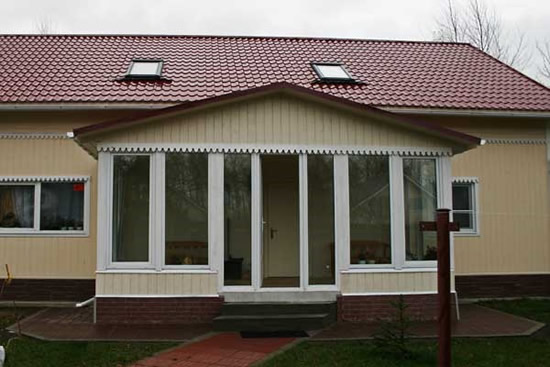
Among the advantages of vinyl siding - high performance, a large assortment of colors, ease of installation, affordable price. Horizontal panels make the building very aesthetic.